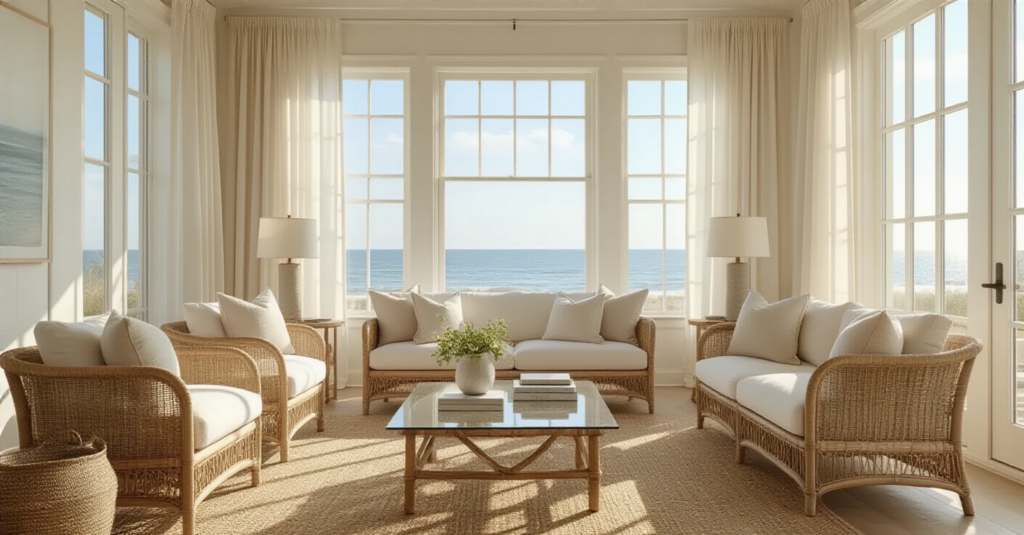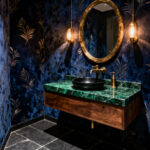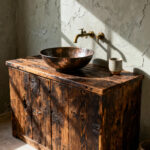Can we talk about why so many people get coastal design wrong? It’s one of my biggest pet peeves. I walk into a house and I’m assaulted by a sea of kitsch—plastic anchors, nets full of fake starfish, and signs that say “BEACH” with an arrow pointing to the sofa. It feels less like a serene escape and more like the inside of a chain seafood restaurant. That’s not what coastal living is about. It’s not a theme.
The real spirit of coastal architecture, from the classic Shingle Style homes of New England to the simple charm of a Cape Cod cottage, was never about decoration. It was about honesty. It was about using materials that could stand up to the salt and the sun. It was about maximizing light and air in a time before central air conditioning. It was about creating a durable, comfortable place for family to gather after a day spent outdoors. So if you want to create a room that genuinely feels like a coastal retreat, you need to forget the clichés and focus on the authentic principles: light, texture, and a deep respect for natural materials.
Foundations & Defining Your Coastal Style
Before you buy a single pillow or piece of art, you have to get the bones of the room right. This is the part that so many people skip, and it’s the reason their rooms end up feeling flat and inauthentic. Getting the foundation right—the light, the color, the very flow of the space—is what separates a timeless room from a trendy one.
1. Ditch the Navy and White (Mostly)
You know what people always ask me? “What shade of navy blue should I use?” And I tell them to start by looking out the window, not at a paint chip. A real coastal palette is so much more subtle and interesting than just navy and white. Think about the colors of a real coastline: the pale, hazy blue of a morning sky, the muted green of sea grass, the complex gray of a foggy day, and the infinite shades of beige and off-white you see in sand, dunes, and sun-bleached wood.
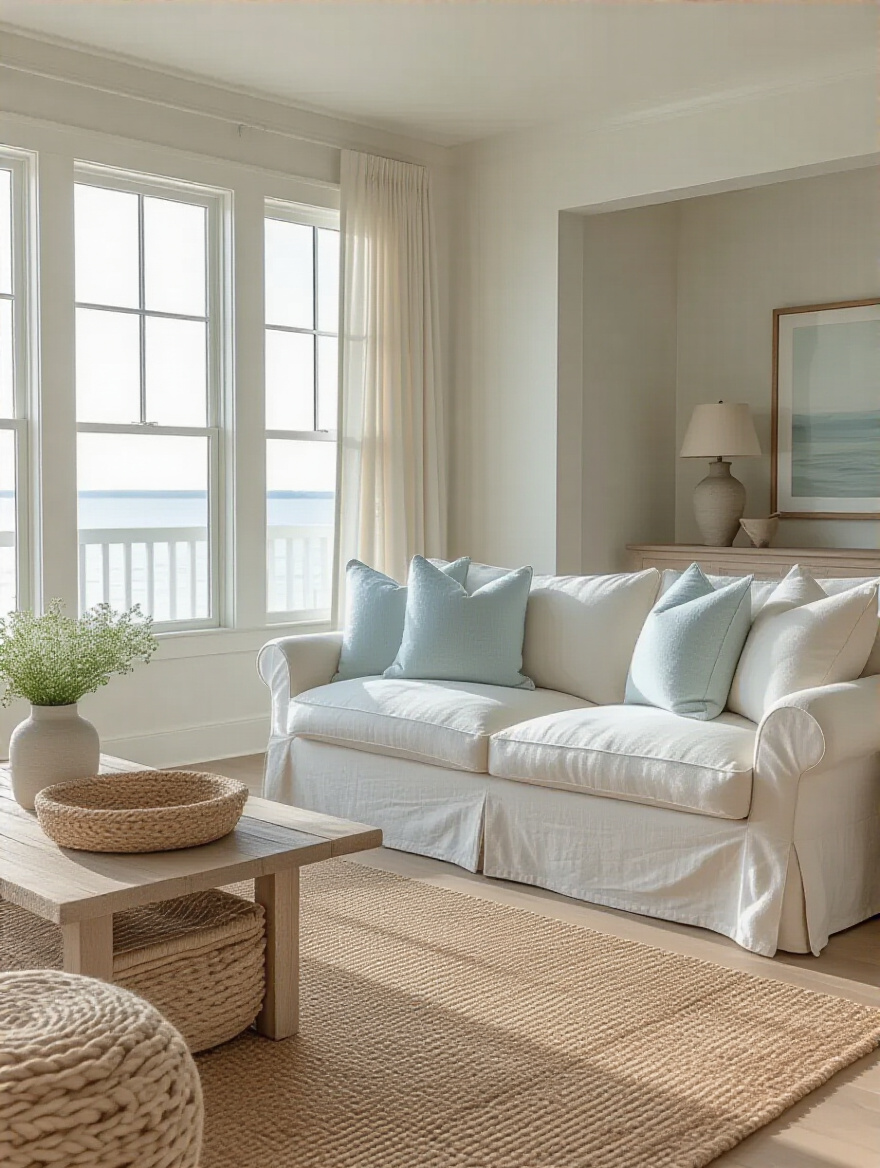
This is the palette that creates true serenity, because your brain is hardwired to relax in these natural tones. Start with a foundational color for your walls—something soft and light-reflecting, like a creamy off-white or a very pale, warm gray. Then, you can layer in those soft blues and greens. The key is to keep it muted. Instead of a hard, graphic navy, think of the dusty blue of worn denim. It’s about evoking a feeling, not painting a flag.
Now that the room has the right color, let’s talk about its most important feature: the light itself.
2. Treat Natural Light Like Gold
Before electricity, the design of a coastal home was completely dictated by the sun. Architects would orient a house and place windows specifically to capture light and breezes throughout the day. It was the original “smart home” technology. The biggest mistake you can make is to fight against that brilliant, natural design by covering it all up.
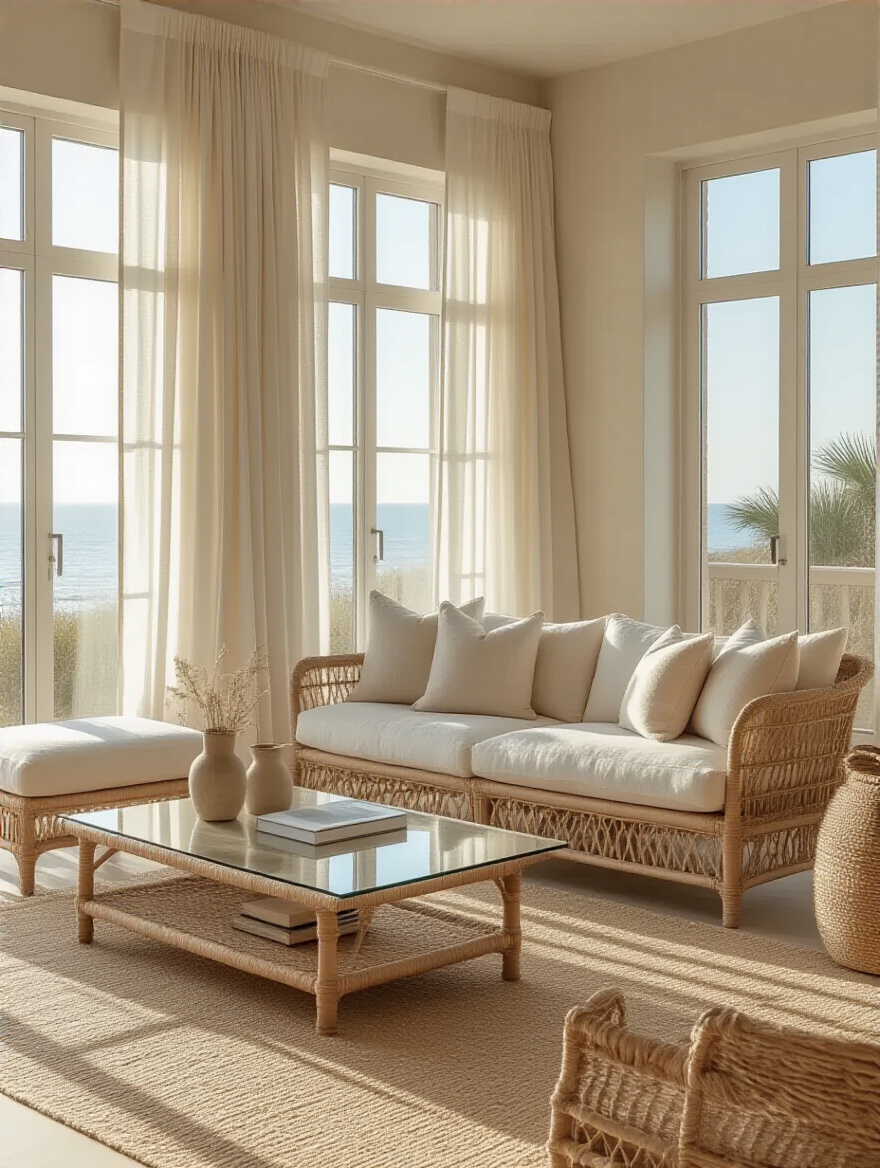
Heavy drapes have no place here. They block light, collect dust, and suffocate the room. Instead, you want simple, light-filtering window treatments that offer privacy without sacrificing sunlight. Think sheer linen or gauzy cotton curtains that move with the breeze. The other classic trick is a big mirror. Placing a large mirror on the wall opposite your main window can literally double the amount of light in the space, and it creates the illusion of another window. It’s a simple, architectural solution that honors the home’s need to breathe.
Once the room is filled with light, it’s time to think about where you’ll sit to enjoy it.
3. Arrange Seating for Living, Not for Show
A coastal home was always a place for gathering. It needed to be comfortable, practical, and inviting. The goal is to create arrangements that encourage conversation and lingering, not a stiff, formal setup where everyone feels like they’re on display. Face sofas and chairs towards each other, not just pointing them all at a TV. Create a natural flow that makes it easy for people to move around and pull up a seat.
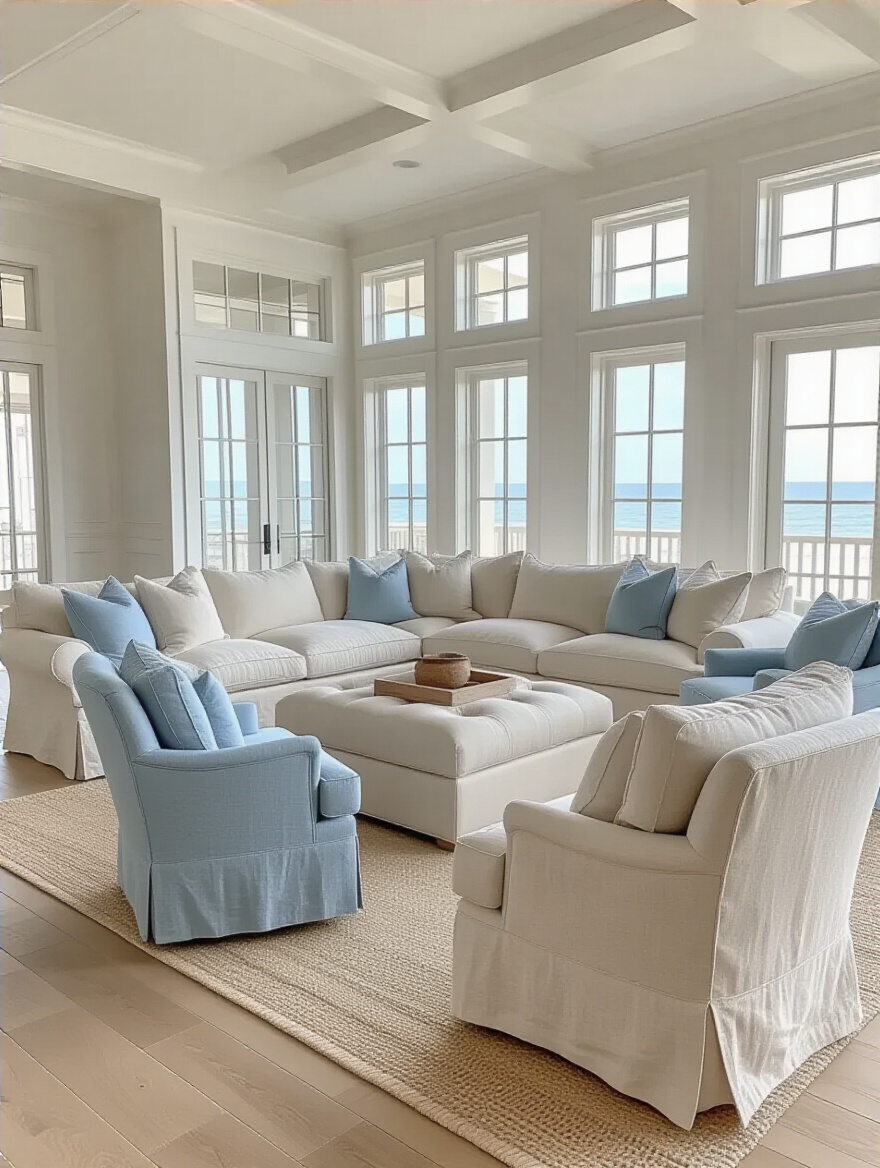
I remember a client who had this beautiful, but terribly uncomfortable, modern sofa. Nobody ever sat on it. We swapped it for a deep-seated slipcovered sofa with tons of soft pillows, and suddenly the living room became the most used room in the house. That’s the test. A coastal living room should feel like it’s giving you a hug—it should be a place where you can curl up with a book, have a long chat with a friend, or take a nap in a sunbeam. It’s about real life.
This emphasis on real-life use brings us to the materials that make it all possible.
4. Use Materials That Can Take a Beating
The beauty of historic coastal homes is that they were built to last. The materials were chosen for their durability and honesty: solid wood floors that could handle sandy feet, plaster walls, and sturdy, well-crafted furniture. You want to channel that same spirit by choosing natural, enduring materials over cheap synthetics. You can feel the difference, and you can certainly see it.
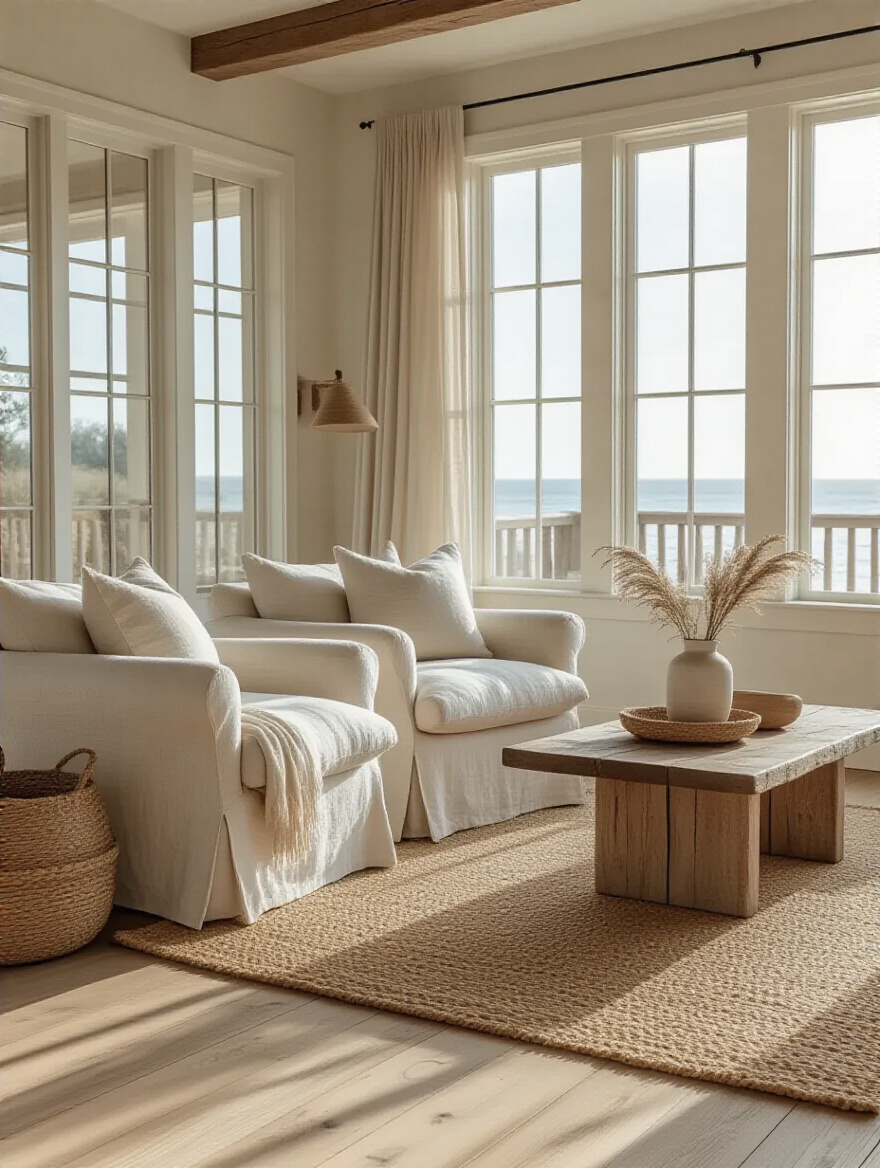
This means investing in pieces made from real wood—like oak, maple, or even teak—not particle board with a wood-look laminate. It means choosing fabrics like linen, cotton, and wool. These materials have a life to them; they breathe, they get softer with age, and they have imperfections that give them character. A floor-to-ceiling wall of slick, synthetic shiplap feels cold and dead. Real wood planks, with their subtle variations in grain and color, feel warm and alive.
The ultimate goal is to erase the line between your beautiful interior and the nature just outside.
5. Blur the Line Between Inside and Out
The whole point of a coastal home is its connection to the environment. The classic front porch or sunroom was the original version of this—a transitional space that was neither fully indoors nor fully outdoors. Today, we can achieve that feeling in more dramatic ways by creating seamless connections that make the living room feel boundless and airy.
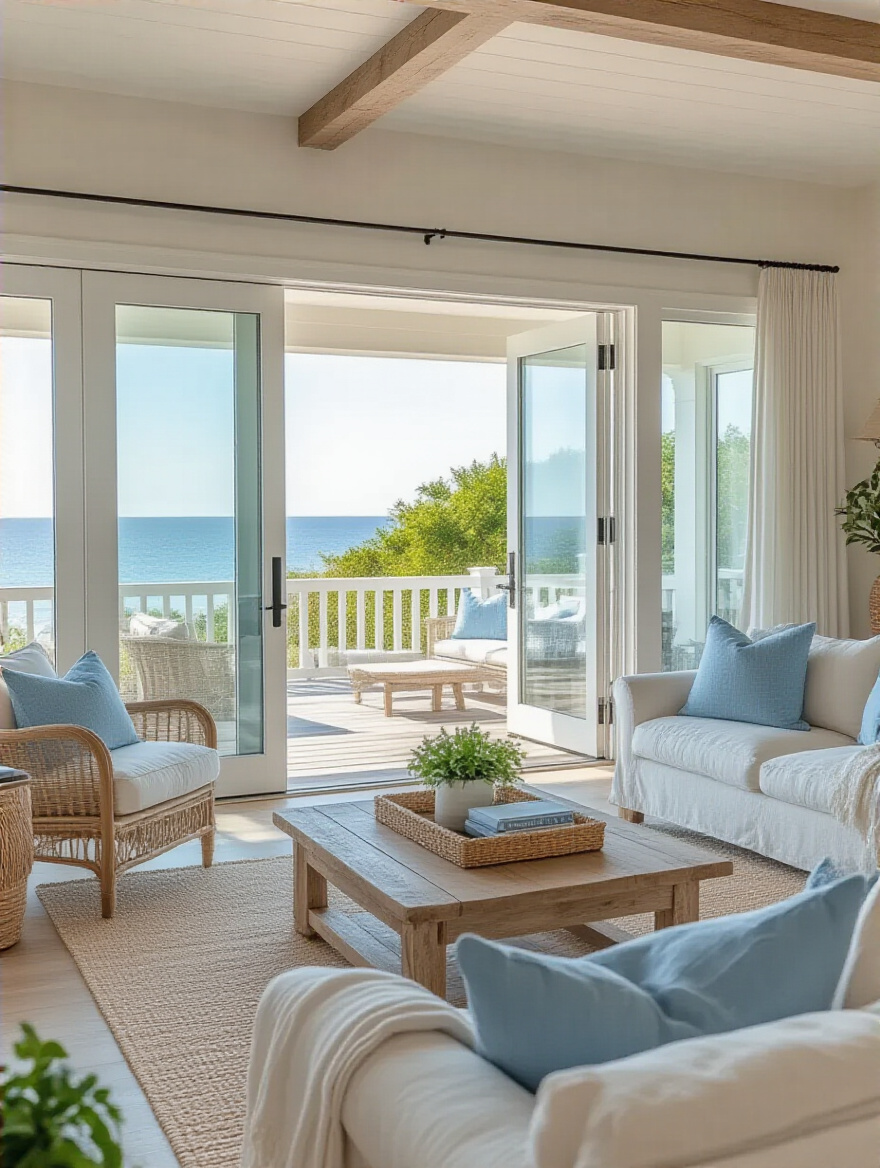
If you’re renovating, this is where things like bi-fold or multi-slide glass doors can be transformative, allowing you to literally open an entire wall to a deck or patio. But you don’t need a massive renovation to get the effect. The simple act of using the same or similar flooring material inside and out can trick the eye. Or, choose outdoor furniture for your patio that mirrors the style and comfort of your indoor pieces. It’s all about creating a continuous visual flow that invites the light, air, and sounds of the outdoors to become part of your living space.
Furnishing & Functional Coastal Elements
Okay, the foundation is set. The room feels right. Now we get to the fun part: filling it with furniture and fixtures that enhance that easy-going, yet sophisticated, coastal spirit. Every piece should serve a purpose and add to the room’s character.
6. Embrace the Slipcover
I used to think slipcovered furniture was just for people who were afraid of commitment. Then I worked on a 1920s beach cottage restoration and I got it. Slipcovers aren’t a modern invention for “coastal chic”; they’re a brilliantly practical, historic solution. In homes exposed to sun, sand, and salty air, a slipcover protected the expensive upholstery on a well-made sofa or chair. You could take it off, wash it, and it was good as go.
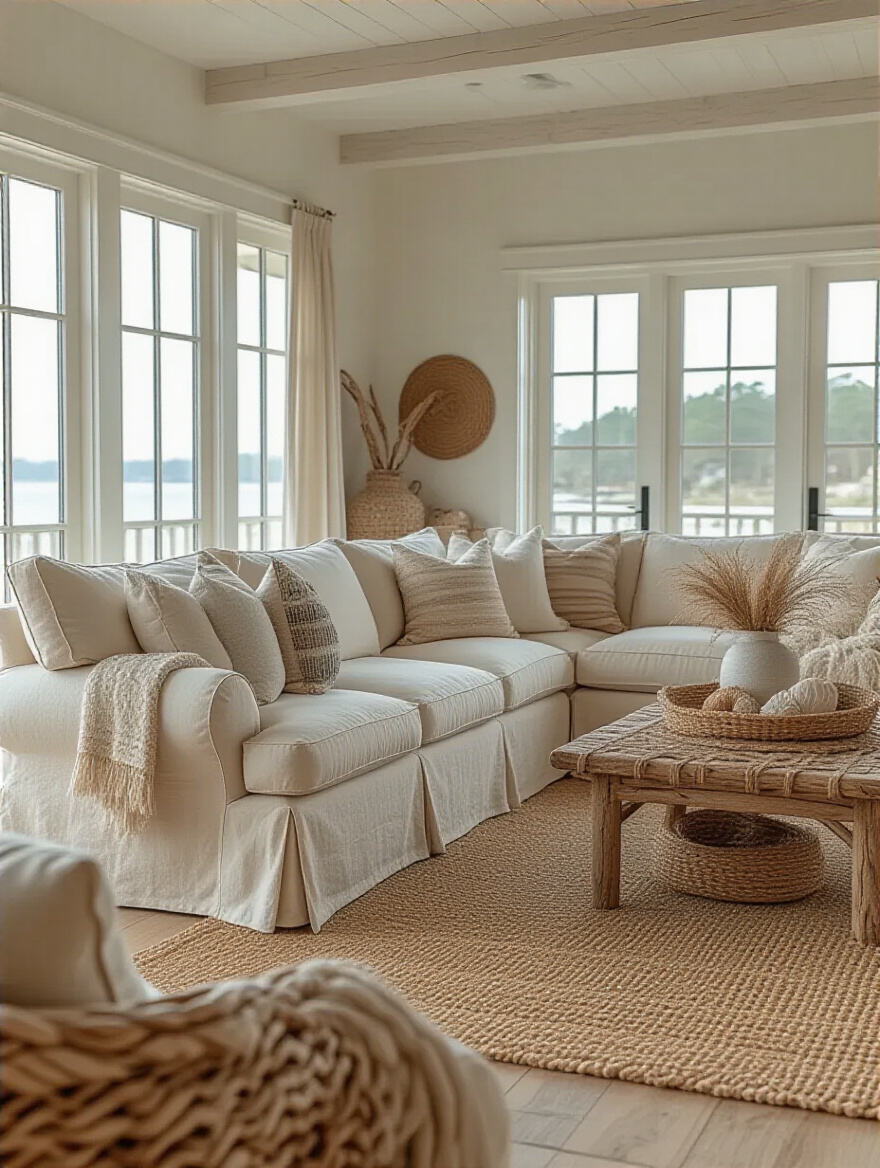
This is the ultimate shortcut to that relaxed, unpretentious coastal feel. It says, “Come on in, put your feet up, don’t worry about spilling.” Opt for high-quality, durable fabrics like pre-shrunk cotton canvas or a hefty linen blend. A well-tailored slipcover on a quality furniture frame looks incredibly high-end and sophisticated, while offering a level of practicality that’s essential for a truly livable room.
With the main seating sorted, it’s time to ground the space.
7. Find the Right Rug (and Make It Big Enough)
Everyone says you need a natural fiber rug like jute or sisal for a coastal room, but they often forget to explain why. It’s not just about the look; it’s about the texture. A room with only smooth surfaces—drywall, glass, polished floors—feels sterile. A big, chunky, natural-fiber rug introduces an earthy, organic texture that acts as the perfect counterpoint, grounding all the light and airy elements. It’s like adding the feeling of sandy earth right under your feet.
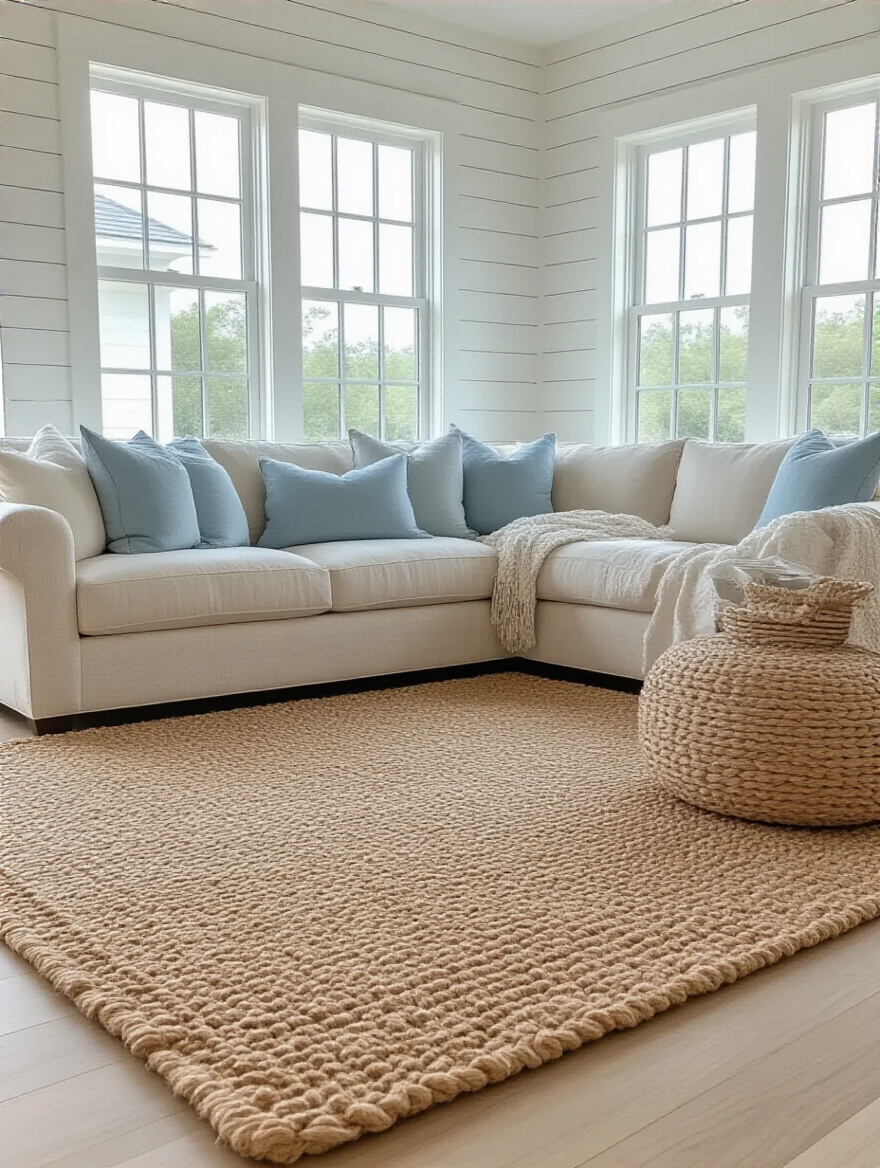
Here’s the shortcut I wish everyone knew: buy the bigger rug. A small rug floating in the middle of the floor makes the room feel smaller and disjointed. You want a rug that’s large enough for at least the front legs of your sofa and all your chairs to sit on. This visually ties the entire seating arrangement together into one cohesive unit, making the space feel more generous and intentional. Layering a smaller, softer rug on top is a great pro-move for adding even more texture and comfort.
Now let’s put something in the middle of that rug.
8. Get a Coffee Table with Character
Please, I beg you, skip the matching furniture sets. A coastal room should feel collected over time, not bought in one trip to the store. The coffee table is the perfect place to inject some authentic character. Look for something made of weathered, reclaimed wood, or a sturdy piece of woven rattan or wicker. These materials bring that essential organic, textural element right to the center of your room.
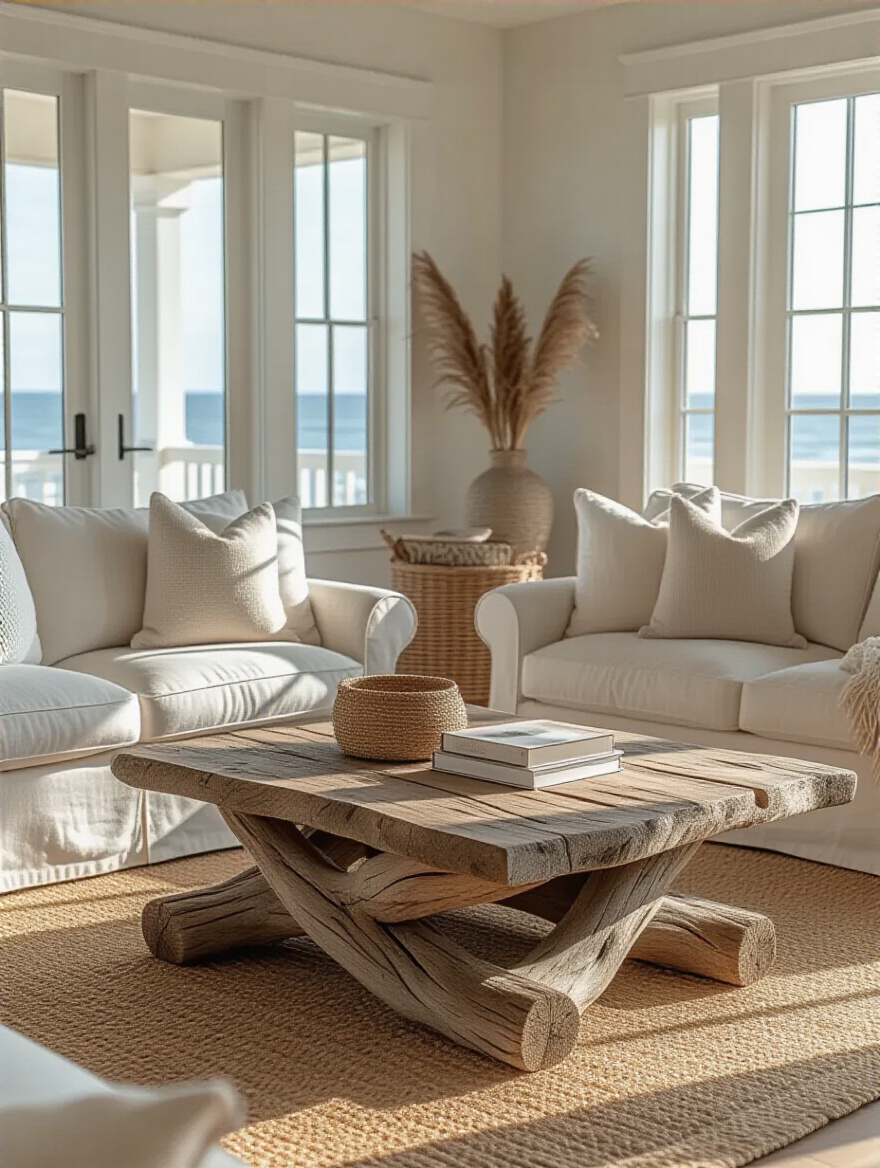
The goal is to find a piece that has some soul. A real slab of driftwood is fantastic if you can find one, but a simple, beautifully crafted pine table that will gain its own dings and water rings over time is just as good. The point is the honesty of the material. A table like this serves as a beautiful, rustic anchor for the whole space and keeps the room from feeling too precious or delicate.
Let’s look up and think about how to light this space after the sun goes down.
9. Hang a Light Fixture That Adds Texture
Lighting in a coastal home should be warm and diffuse, not harsh and clinical. You want to create a soft, inviting glow in the evenings. Woven pendant lights made from rattan, seagrass, or rope are incredibly popular for a reason—they do this perfectly. They act as sculptural, textural elements during the day, and at night, they cast a beautiful, dappled light that feels warm and atmospheric.
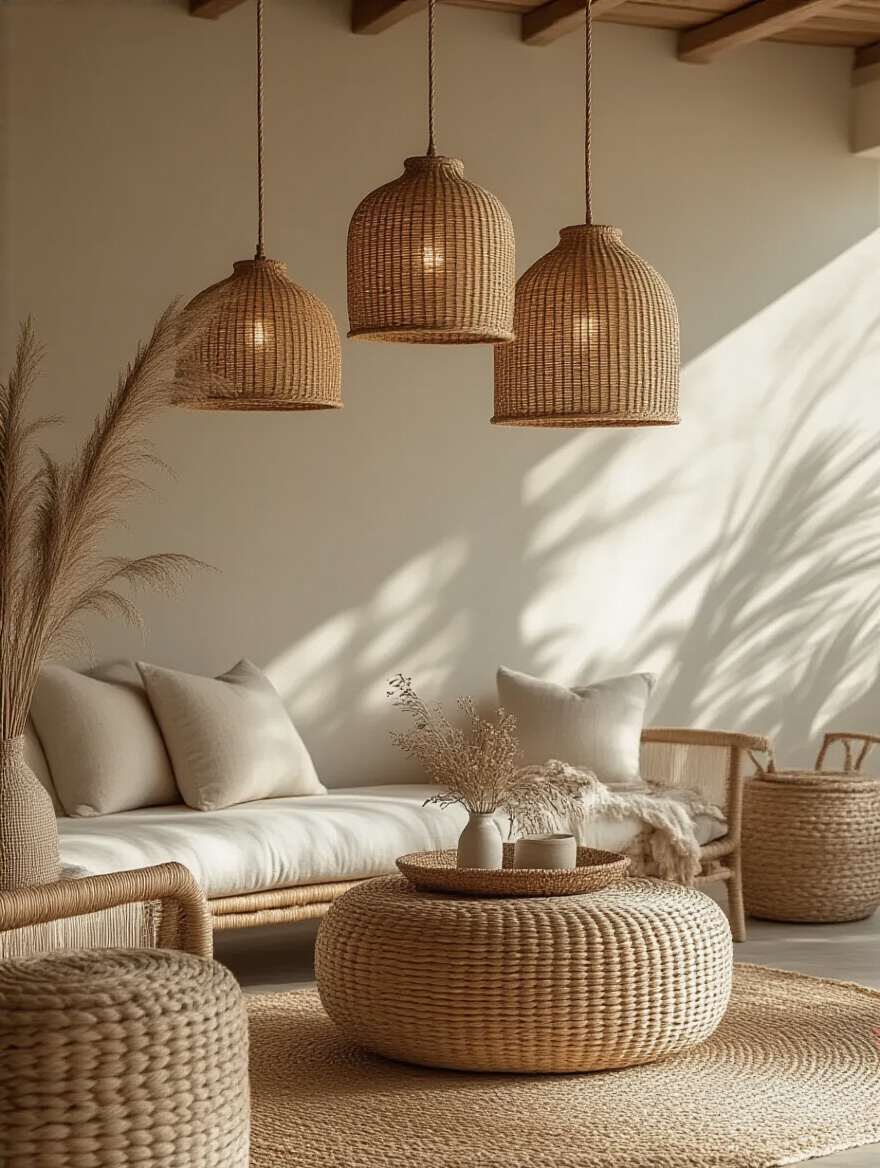
The key is to think of your light fixtures as functional art. One large, dramatic pendant over the main seating area can define the space and act as a stunning focal point. Don’t just rely on recessed can lights, which can feel cold and create harsh shadows. And for the love of all that is good, put everything on a dimmer switch. This is the single most important tool for controlling the mood of your room.
Finally, let’s talk about the unsung hero of serene living: storage.
10. Hide Your Junk with Smart Built-Ins
A calm coastal oasis cannot coexist with clutter. It just can’t. Historic homes were masters of clever storage, and built-ins are the absolute best way to achieve an uncluttered look because they become part of the architecture itself. Think of a classic window seat with a hinged lid for blanket storage, or floor-to-ceiling bookshelves flanking a fireplace. They feel intentional and substantial, unlike a random piece of furniture pushed against a wall.
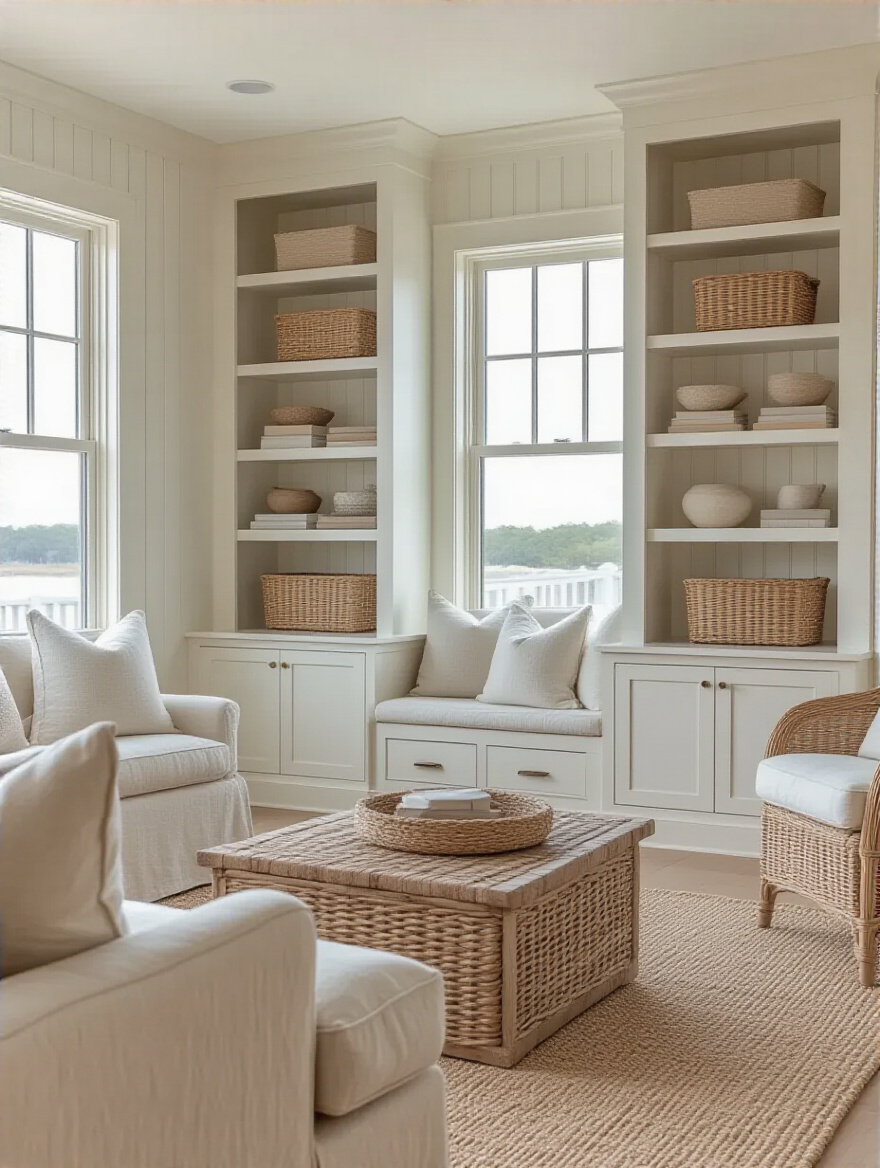
I once worked on a project where we turned a useless, narrow alcove into a full-height built-in with concealed cabinets below and open shelving above. It single-handedly solved the family’s storage problems and instantly made the entire room feel more organized, spacious, and high-end. It’s the ultimate investment in sanity, seamlessly hiding the clutter of modern life (remote controls, chargers, kids’ toys) behind a serene, integrated facade.
Accessorizing & Bringing in Oceanic Textures
Alright, the heavy lifting is done. The room is furnished and functional. Now comes the part that truly brings it to life. Accessorizing is about layering in those final details that tell a story and engage the senses, making the room uniquely yours.
11. Layer on the Linen and Jute
Texture is everything. It’s the difference between a room that looks good in a photograph and one that feels good to live in. Luxurious, natural fabrics like linen and jute are your best friends here. Linen, with its characteristic slub and soft, lived-in wrinkle, is the epitome of relaxed elegance. Use it for pillows, throws, or even those sheer curtains we talked about.
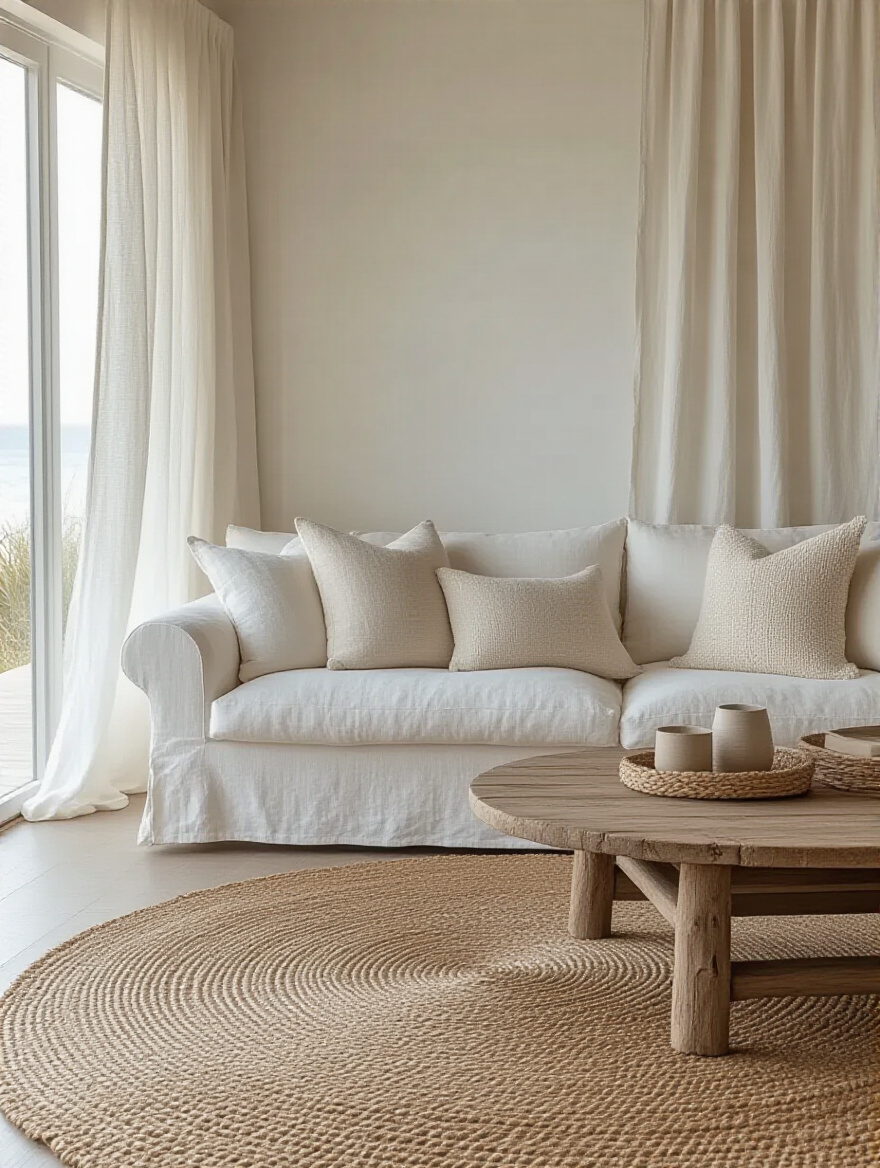
Jute isn’t just for rugs. You can find it in poufs, baskets, and even woven wall hangings. It brings in that robust, earthy texture that provides a beautiful contrast to softer materials like linen and cotton. Don’t be afraid to mix them. A chunky jute basket holding a soft, folded linen throw is a perfect little vignette that embodies the entire coastal aesthetic: rustic and refined, durable and comfortable.
These textures will serve as the backdrop for more personal treasures.
12. Style Your Shelves Like a Curator, Not a Collector
This is where you inject your personality. But please, step away from the big-box store’s “Coastal Decor” aisle. Your shelves should tell a story, not look like a staged catalog. The key is to source authentic, meaningful items. Scour flea markets, antique shops, or even your own beachcombing trips for unique finds. An old, sun-bleached buoy, a stack of vintage navigational charts, a brass barometer—these things have history and soul.
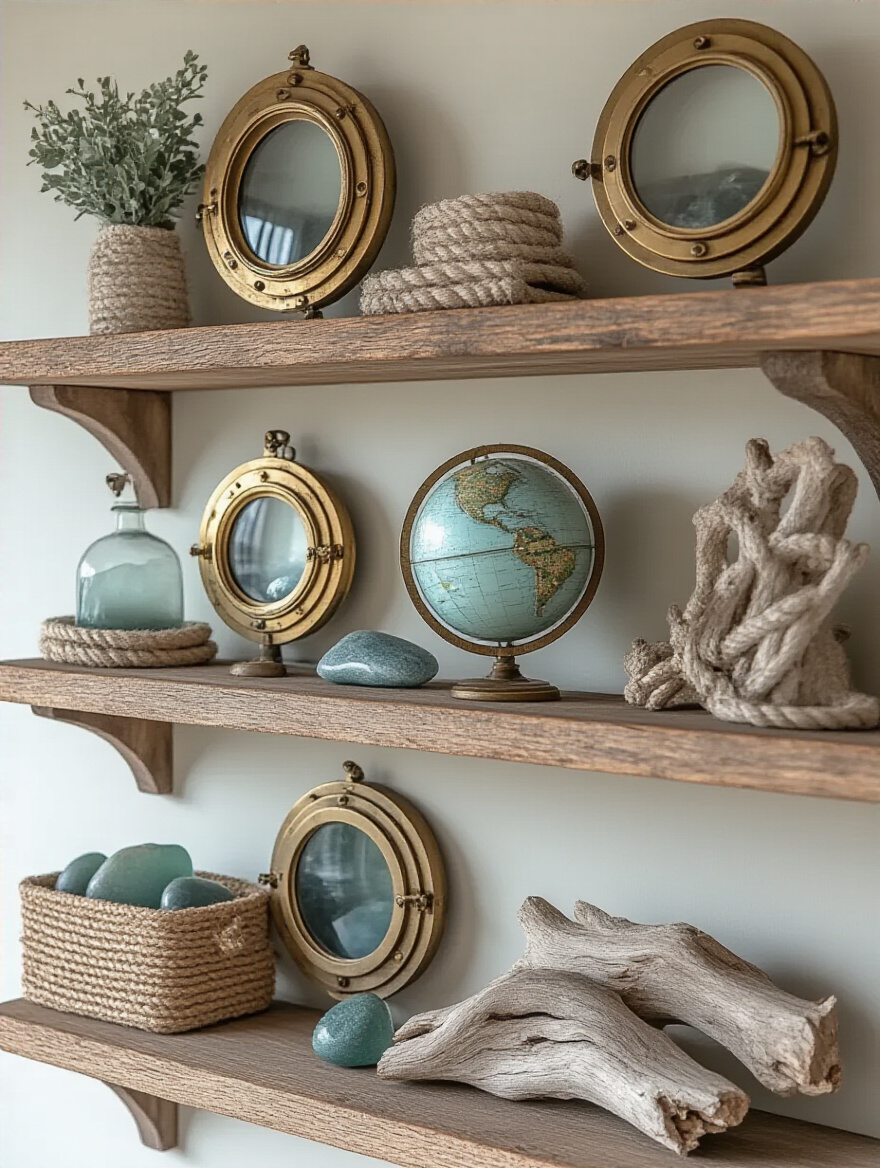
The biggest mistake is clutter. You need to edit ruthlessly. One single, spectacular piece of driftwood is infinitely more powerful than twenty tiny, random objects. Group items in small vignettes, vary their height and texture, and most importantly, leave some empty space. Negative space allows the eye to rest and gives the objects you do display the importance they deserve.
Now, let’s zoom in on the smaller, more precious finds.
13. Use Shells and Sea Glass Sparingly, Like Jewels
Seashells, coral, and sea glass are the jewelry of a coastal room. And like jewelry, less is more. You’re not decorating a sandcastle; you’re creating a sophisticated living space. A handful of beautiful, water-smoothed pieces of sea glass in a clear glass jar or one large, perfect conch shell placed on a stack of books can be an incredibly elegant and powerful accent.
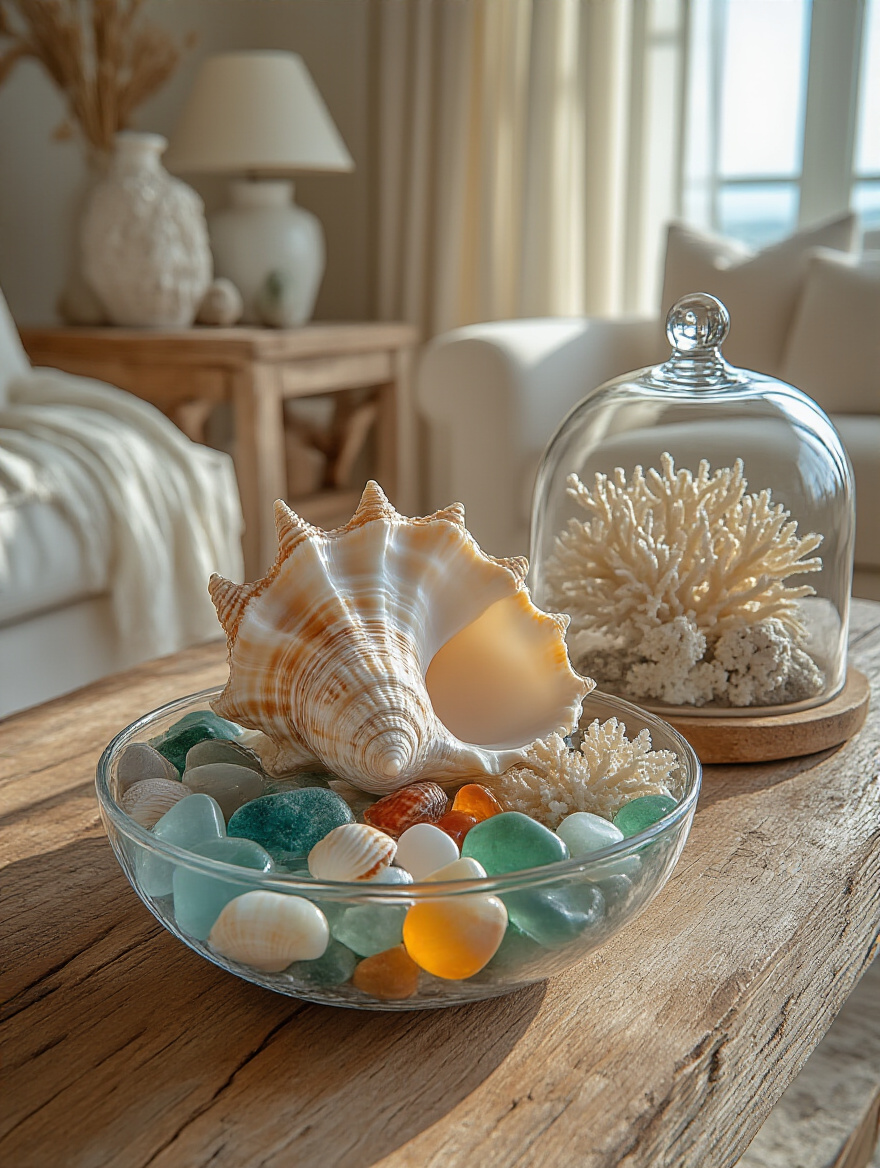
The key word here is “curated.” Choose your best finds. Display them thoughtfully. This approach elevates these natural treasures from simple beach clutter to objets d’art. And a critical note on coral: only ever buy ethically sourced or high-quality replica pieces. The real stuff is vital to our ocean ecosystems. Being a steward of a coastal home means respecting the coast itself.
From small treasures, let’s move to the walls.
14. Make Your Walls Work Harder with Mirrors and Art
Your walls are an opportunity to amplify the best features of your room. As we discussed, a large, well-placed mirror is a functional powerhouse, boosting light and creating a sense of space. But you can take it a step further by choosing a mirror with a frame that adds to the coastal feel—something made of weathered wood, woven rattan, or even simple, whitewashed pine.
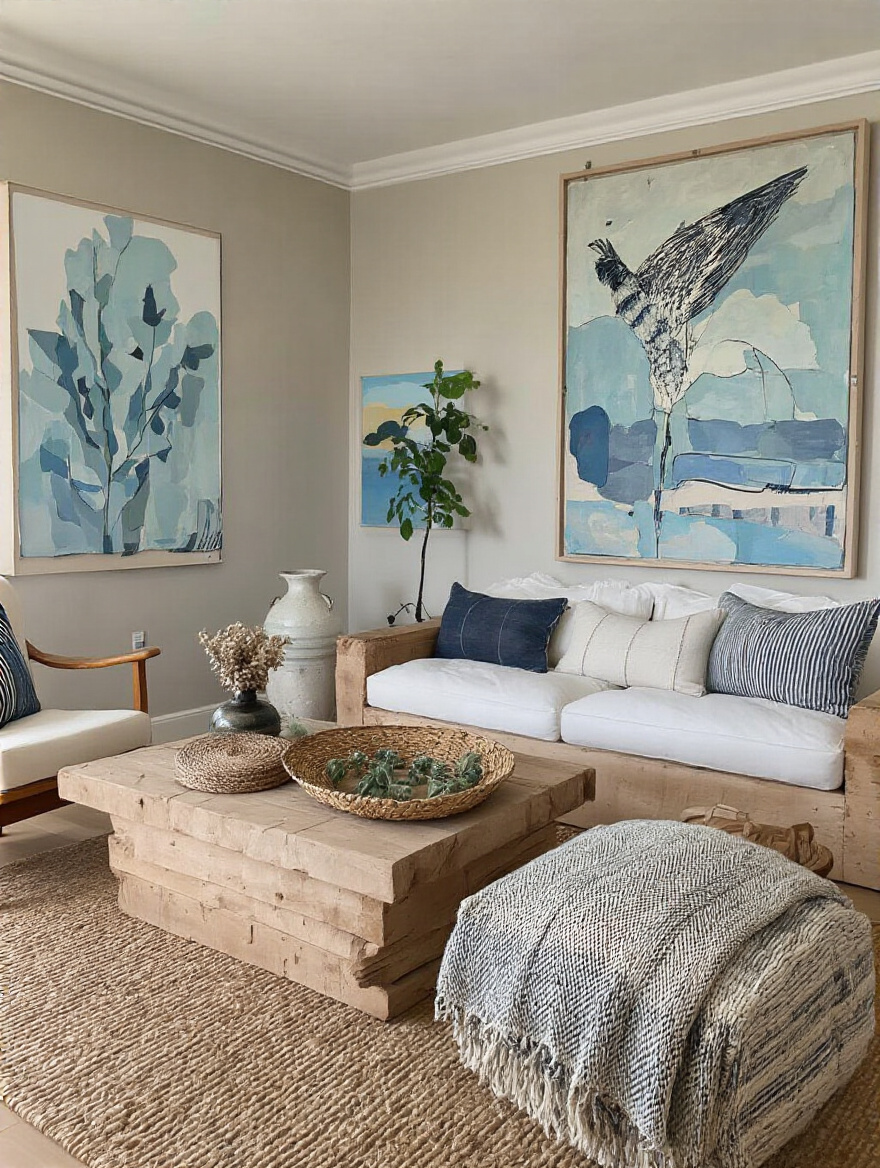
When it comes to artwork, try to move beyond the literal. Instead of a painting of a boat, look for art that captures the feeling of the coast: the abstract textures of sand and water, the subtle colors of a sunset, or the dramatic movement of clouds over the ocean. This creates a more sophisticated and enduring look that will resonate on a deeper level than a simple cliché image.
And finally, let’s add the final layer of touchable comfort.
15. Pile on the Pillows and Throws
This is the easiest, most cost-effective way to add comfort and personality. A sofa is just a sofa until you add a handful of great pillows and a soft throw. This is your chance to play with texture and subtle patterns without a big commitment. Mix a chunky knit throw with smooth linen pillows and maybe one with a simple, block-printed stripe.
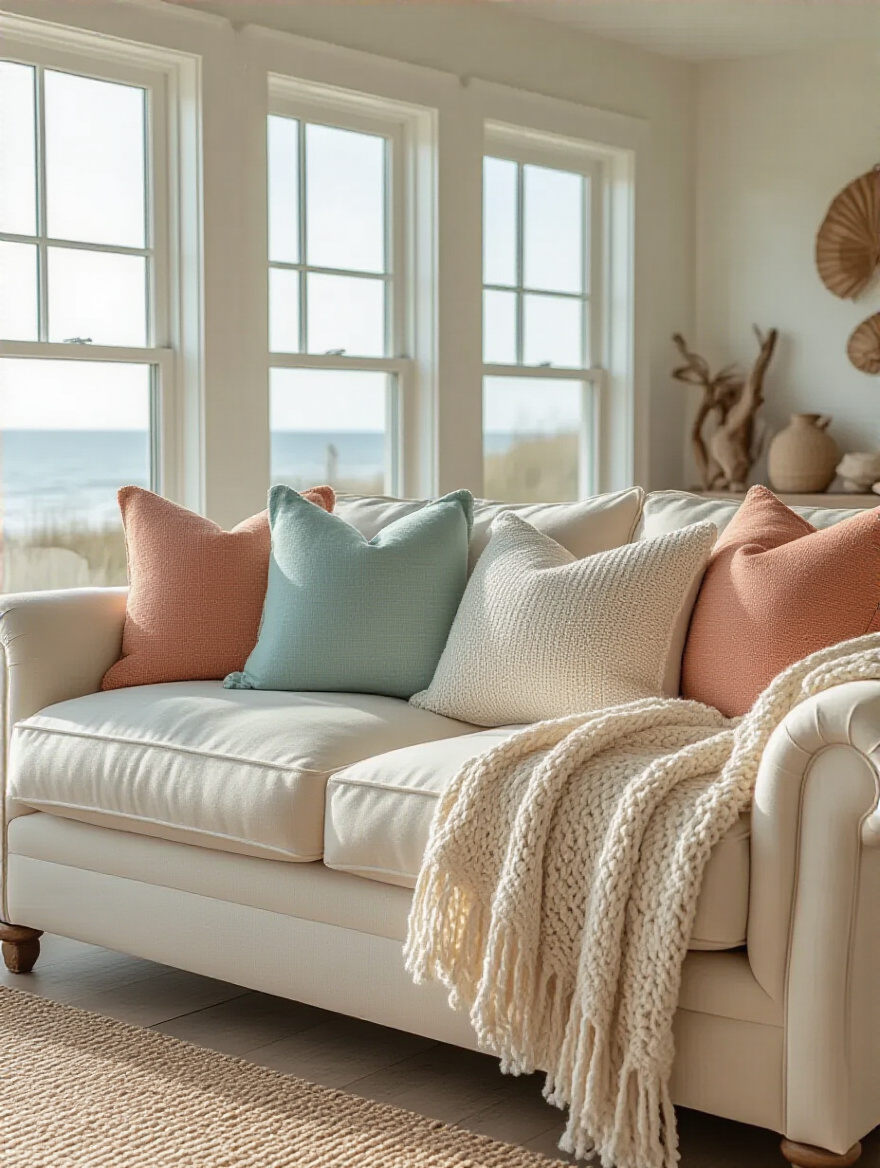
Here’s a simple designer trick that always works: the Rule of Odds. When arranging pillows on a sofa, use an odd number—three or five. It looks more natural and less rigidly staged than a perfectly symmetrical pair. Drape a throw casually over the arm or the back of the sofa. It’s an open invitation to get comfortable.
Elevating the Ambiance & Personalizing Your Retreat
We’re in the home stretch. The room looks great, it feels great. These final steps are about engaging all the senses to turn a beautiful room into an immersive, personal sanctuary.
16. Bring in Greenery That Belongs
Plants breathe life into a space, literally and figuratively. They are a crucial bridge between your indoor oasis and the natural world outside. For a coastal vibe, you want plants that feel like they could plausibly survive near the coast—hardy, structural, and not overly fussy. A tall, elegant Kentia Palm or a sturdy Snake Plant can add a wonderful vertical element and a touch of the tropics.
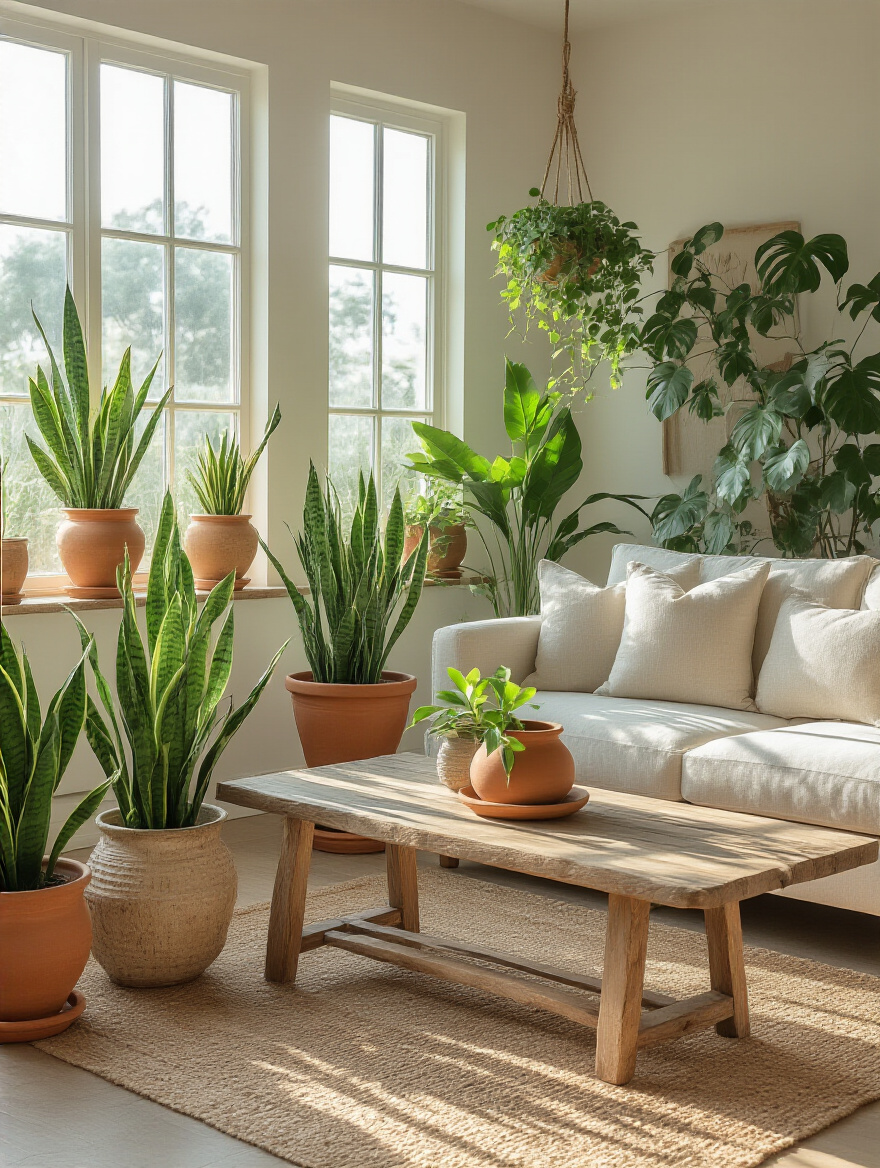
The trick is to choose low-maintenance varieties so they don’t become another chore. And pay attention to the planters! A beautiful plant in a cheap plastic pot just cheapens the whole look. Opt for pots made of natural materials like terracotta, light-colored ceramic, or woven seagrass baskets to continue the room’s textural story.
From sight, let’s move to scent.
17. Use Scent to Set the Mood (Subtly!)
Scent is a powerful, often overlooked, element of design. The right fragrance can instantly transport you and solidify the room’s serene atmosphere. The key here is subtlety. You are not trying to blast your home with a synthetic “Ocean Breeze” plug-in that smells like a car air freshener.
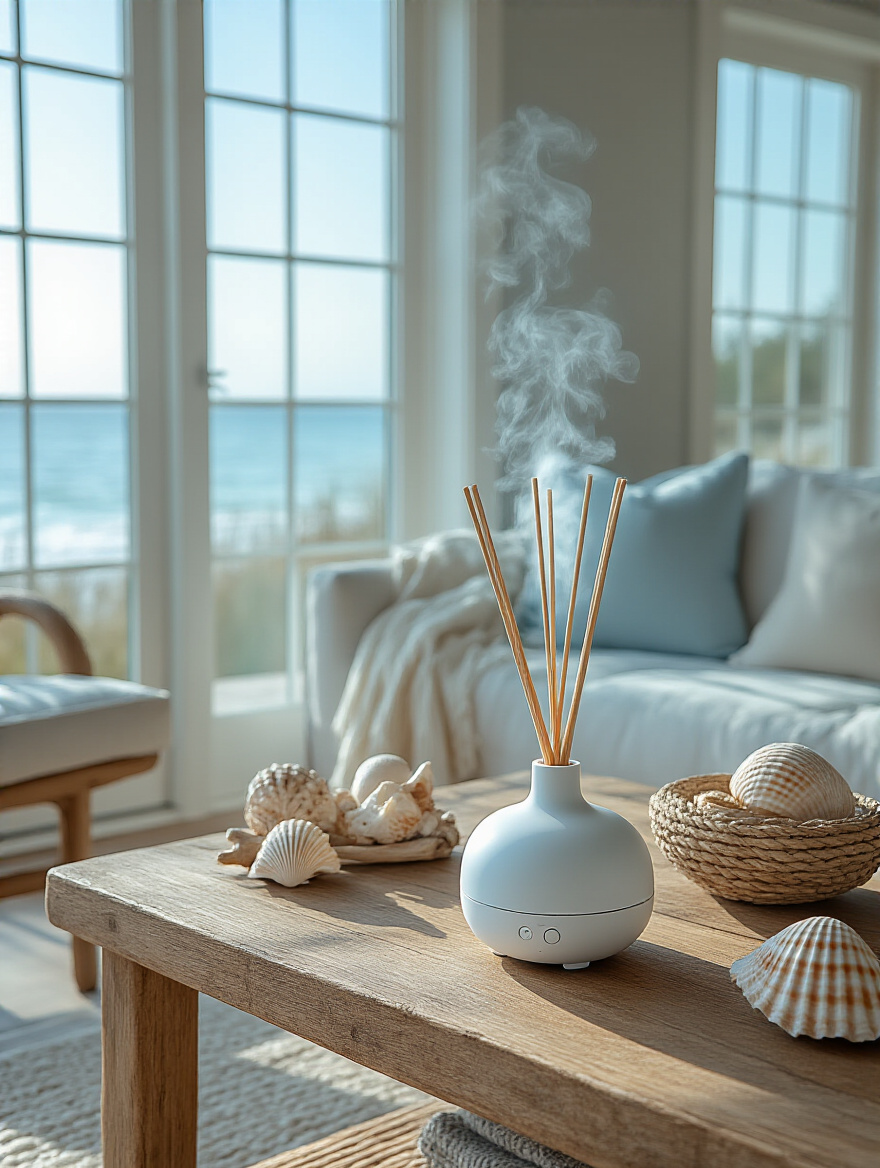
Instead, think natural and clean. A high-quality essential oil diffuser with notes of sea salt, driftwood, or even a light citrus like bergamot can create a sophisticated, background ambiance. Even better? The simple, clean scent of fresh linen, or just opening the windows and letting the actual fresh air in. The goal is a scent so subtle you barely notice it, but you’d miss it if it were gone.
Now, let’s circle back to one of my favorite architectural elements.
18. Emphasize Character with Distressed Wood
If you’re lucky enough to have authentic architectural features in your home, showcase them. If not, you can add them. Reclaimed wood is the soul of coastal and historic design. Using it to wrap a ceiling beam, create a mantelpiece, or even as an accent wall brings an unparalleled sense of history and warmth into a room. The natural imperfections—the nail holes, the weathering, the patina—tell a story that no factory-distressed finish ever could.
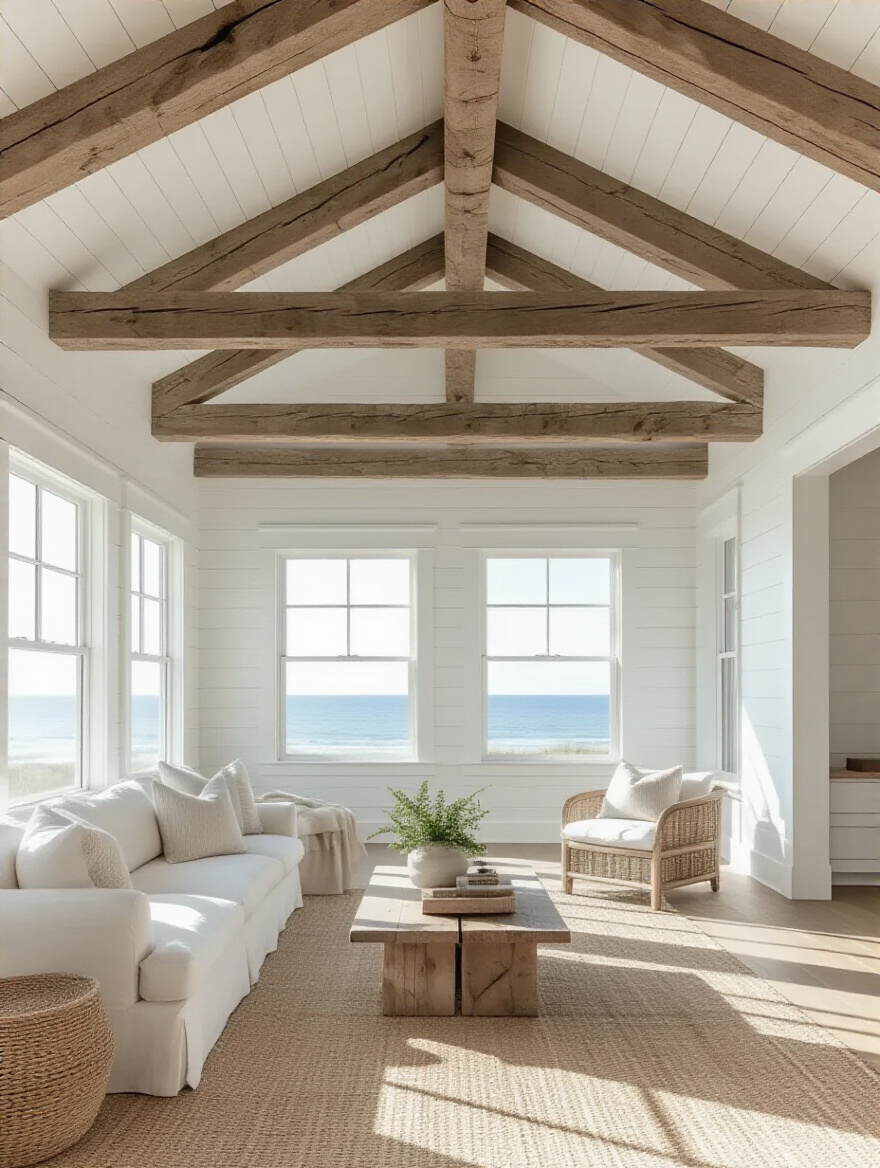
A whitewashed or limed finish on existing wood can also look stunning, brightening the space while still highlighting the wood’s natural grain. A client of mine had a dark, heavy mantel that dominated their living room. We clad it in reclaimed, naturally weathered grey barn wood, and it instantly became the room’s most beautiful and authentic feature. It grounded the entire design in a way that nothing else could.
This brings us to the natural heart of any living room.
19. Make the Fireplace a Calming Focal Point
The fireplace is the traditional heart of the home, a natural gathering spot. In a coastal design, it should be a focal point of calm, not heavy ornamentation. Strip it back. Keep it simple. Think clean lines and natural materials. Cladding a brick fireplace in classic white shiplap or smooth plaster instantly brightens it and gives it a coastal feel.
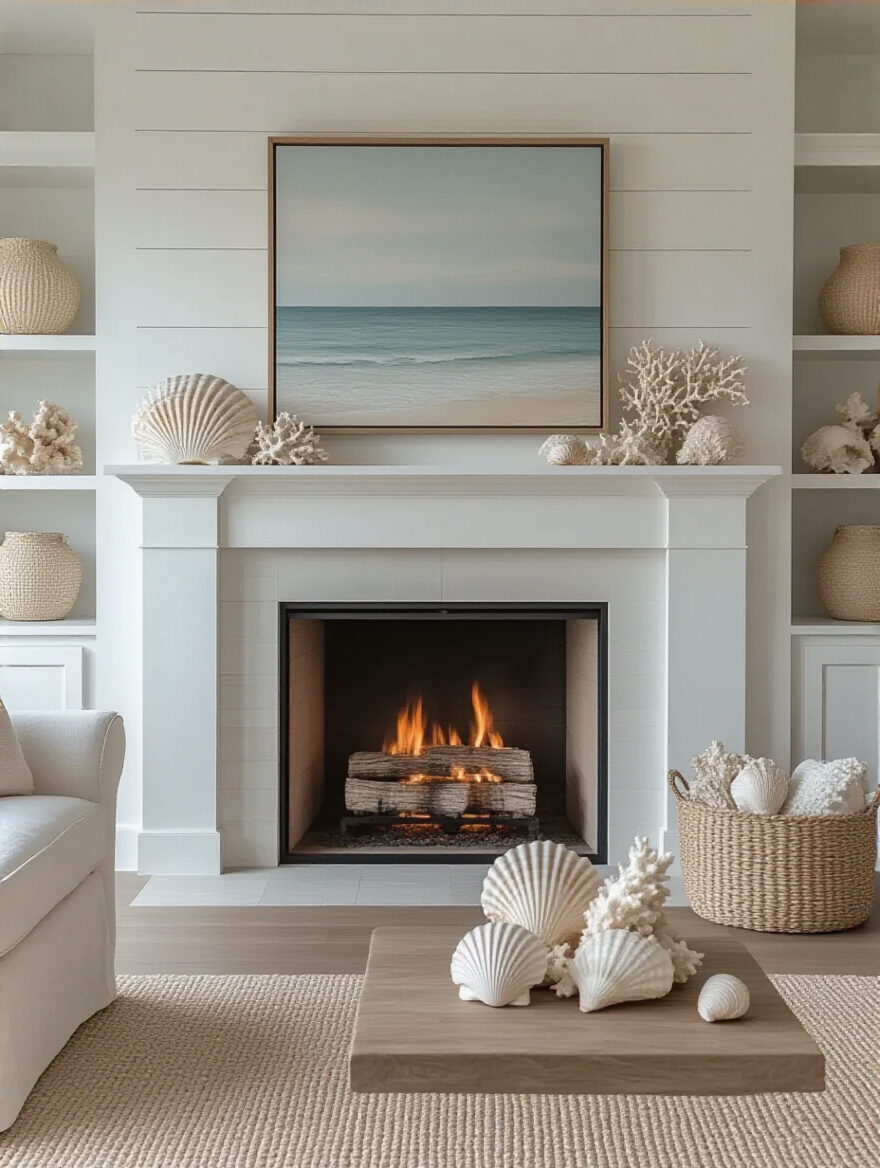
A simple, chunky mantel made from a piece of reclaimed wood or painted a crisp white is all you need. Keep the decor on the mantel minimal and curated—that one beautiful piece of driftwood, a simple round mirror, a piece of art. The fireplace anchors the room’s layout and its emotional tone. By making it a beacon of simple, clean design, you solidify the entire serene, coastal feeling you’ve worked to create.
Conclusion
So, there you have it. Creating a genuine coastal living room isn’t about following a decorating checklist or buying a basket of shells. It’s about cultivating a feeling. It’s an approach to design that prioritizes light, air, comfort, and the honest beauty of natural materials. It’s about creating a space that functions for real life, a durable and welcoming sanctuary that feels just as good as it looks.
By layering these elements—from the foundational color palette and light to the final, personal touches—you’re building more than a pretty room. You’re crafting a retreat that echoes the timeless, calming spirit of the coast itself. You’re creating a home that feels lived-in, loved, and deeply connected to the natural world. Now, forget the clichés, trust your instincts, and go create the authentic haven you deserve.
